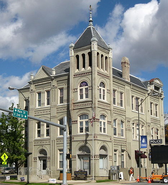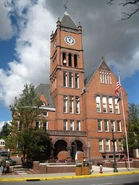From Ashes We Rise | ||||||||
| Capital (and largest city) |
Bloomsburg | |||||||
| Language | English | |||||||
| Legislature | Town Council | |||||||
| Mayor | Vince Delmelfi (D) | |||||||
| Area | 4.7 sq mi | |||||||
| Population | 7,692 (2020 Census) | |||||||
| Admission | June 23, 2010 | |||||||
Bloomsburg is the capital city of the Commonwealth of Susquehanna, and currently the second largest community. The town is also coterminous with the federal district of the District of Scranton and is an enclave of Columbia County.
Pre-Doomsday[]
The area was first settled by a man named James McClure in 1772, who built a log cabin on the site of what would become the town. Until the mid 19th century, it was only known as Bloom Township, but grew after a coal boom. On March 4th, 1870 the village was incorporated as a town. Before Doomsday it became known as the only incorporated town in Pennsylvania. McCandless Township had taken the name the Town of McCandless, although it was not classified as one. It was known for Bloomsburg University, and the Bloomsburg Fair held in the fall. As of the last census in 1980, the town had 11,717 individuals.
Doomsday[]
The town was not a target in the nuclear war between the USA and the USSR. Many individuals feared a conventional strike on the Susquehanna Steam Electric Station. That attack never came, but many fled west to escape radioactive fallout.
The entire town council and police force, as well as former members of the state government convened and formed a small provisional state in the city. They used the small National Guard unit to prevent looting, as well as the town police, college campus security and surviving state police units.
Post Doomsday[]
In the days following Doomsday, a few hundred refugees made it to Bloomsburg from Wilkes-Barre and Scranton. Others settled in Berwick, but most fled south to Hazleton. Town authorities were not overwhelmed and simply housed the survivors in the high school and open dormitories at Bloomsburg University. While injuries were common, most were burns, cuts, and broken bones, with a few cases of radiation sickness.
Fallout from strikes on Wilkes-Barre/Scranton and Harrisburg blew south and north of the town, sparing it from much of the radiation. The town government in conjunction with local police, the county sheriff department, State Police, and ROTC unit at Bloomsburg University coordinated disaster response with the Red Cross and Bloomsburg Hospital.
While the town was handling the crisis, there were sporadic outbreaks of violence as desperate citizens broke into the various grocery stores and fought for remaining nonperishable and medical supplies. To address this, the State Police and ROTC members were deployed to secure the grocery stores and warehouses around the town. The town council and county commissioners arranged a rationing system for food, medical supplies and food; releasing a public statement indicating the plan.
Initially, the citizens were upset and unrest arose as the allotted calories per person was barely above a subsistence level, however it was quickly realized that without the plan, everybody in the town would likely starve. Medical personnel and emergency responders received higher allotments due to the strenuous nature of their jobs.
Limited fuel reserves and the surviving vehicles were immediately requisitioned by local authorities and redistributed to law enforcement, military personnel, and emergency responders. Laborers were sent into the woods to cut down lumber to replace the natural gas and oil supplies for heat that would quickly dwindle without new sources.
As winter settled into the region, officials from Bloomsburg University and the local government organized committees intended to help the region survive until state or federal aid would arrive.
1984-1989[]
By the New Year, the population of Bloomsburg had settled into the new normal of the post-Doomsday world. County authorities were responsible for general affairs including food and fuel distribution, resettling refugees, medical care distribution, as well as defense from the gangs that were beginning to appear. The town authorities handled local law enforcement, public complaints, and local governance to keep the community running.
As the winter weather melted away, the town attempted to figure out how many people survived the winter and was somewhat dismayed to realize that nearly one thousand people had either perished or fled between the 1980 census and May of 1984. County authorities were interested in making contact with possible survivors in Danville, Berwick, and other surrounding boroughs.
1990-1999[]
2000-2009[]
2010-2019[]
2020-Present[]
Government[]
The Town of Bloomsburg has two levels of government, federal authorities and local authorities, although in practice only the former controls the town. The town council is the primary executive and legislative branch for the govenment.
Federal[]
The town hosts most of the Commonwealth of Susquehanna's government buildings and offices. All branches of the government maintain most of their functions here. The Governor's office, executive departments, General Assembly, and judicial branch all have a presence.
Similar to the pre-Doomsday District of Columbia, the General Assembly oversees the government of the district. However, in practice local authorities are provided with a high degree of autonomy and the legislature rarely interferes in decisions made.
In conjunction with the town police department, the federal government operates the Susquehanna Capital Police who serve as security and law enforcement for government buildings not under local jurisdiction.
Local[]
Bloomsburg has a town council of six elected members as well as a town mayor. The council operates on a strong mayoral system. They offer minor public transit services along with Berwick and Danville, town police, public water, trash, and sewage, emergency services, and public works.
The town is divided into six districts that each elect one council member, with two additional members as well as the mayor being elected at-large. The Bloomsburg Police Department is responsible for local law enforcement duties as well as providing security in courts and prisoner transport.
Local court is run through the Montour-Columbia District Court.
Bloomsburg Town Council[]
| Party | Councilors |
|---|---|
| Republican Party | 2 / 8 |
| Democratic Party | 5 / 8 |
| Libertarian Party | 0 / 8 |
| Conservative Party | 0 / 8 |
| Progressive Party | 1 / 8 |
Gallery[]
Demographics[]
Bloomsburg has a population of 7,692 people as of the 2020 census. It is the second largest community in the Commonwealth, but has less than one quarter the population in Hazleton, the largest city. There is substantial population growth in the town though, as people relocate there to be closer to government functions, school, and business.
Selection as the Capital[]
The town was chosen as the provisional capital city after the formation of the Provisional Commonwealth of a Pennsylvania. The main reason was the central location, and it had an undamaged courthouse, government buildings, university, and transportation infrastructure. It was also centrally located in the nation.
The provisional government took over the Columbia County Courthouse, and the Caldwell Consistory as a temporary capital and legislative building, respectively. After the official formation of the Commonwealth of Susquehanna the two buildings were officially taken as property of the federal government.
Infrastructure[]
Interstate 80 runs just north of the town, with the government maintaining the section connecting Danville to Bloomsburg. There are also rail lines that provide commercial transportation between Berwick and Danville.
Airport[]
The only airport in Bloomsburg is Bloomsburg Municipal Airport. There are no regular flights to or from the airport as the nation does not operate an airline and foreign airlines have not opened any flights. The Army National Guard occupies the facility as Fort Hauner and it is used as a major military installation. The runway has been left intact for future air operations or foreign aircraft use.
Reading has deployed a pair of P-51 Mustangs and a single EC-130 to the town ar various occasions to both practice take-off and landing at short airstrips as well as provide air patrol for the Defense Force.
Architecture[]
All of Bloomsburg's architecture is classical with no skyscrapers. The tallest structure in the town is the courthouse and two high rises on the campus of Bloomsburg University. Much of the downtown was constructed in the late 1800's and early 1900's with two and three story brick buildings being the most common. Surrounding the downtown to the north, south, and west are residential areas. The university borders the downtown to the east.
The federal government is considering similar laws that former Washington D.C. This would limit the structural height of building to keep the rural feel of the community.
Downtown[]
The downtown of Bloomsburg, along with that of Hazleton form the two most important business districts. It hosts headquarters for most of the companies based in Bloomsburg and Danville.
The downtown has small buildings, mostly three and four stories with a handful of five story buildings dotting the Main Street. Many of the offices are utilized by government agencies, however the first floors are still oftentimes occupied by private businesses.
Mass Transit[]
Bloomsburg is served by the Susquehanna Federal District Transportation Authority. It primarily serves Bloomsburg, but provides weekly intercity bus services to Montour, Northumberland, Schuylkill, and Sullivan counties. It operates five GeMiNi RTS-04 Rapid Transit Buses.
Bus Route
- Bloomsburg Line- Bloomsburg (Capital Transit Hub): ten stops, three buses
- Bloomsburg University Line- Bloomsburg (Capital Transit Hub): fourteen stops, one bus
- Intercity Line- Bloomsburg (Capital Transit Hub) to Berwick: two stops, one bus (Monday, Thursday)
- Intercity Line- Bloomsburg (Capital Transit Hub) to Danville/Northumberland: five stops, one bus (Sunday, Friday)
- Intercity Line- Bloomsburg (Capital Transit Hub) to Laporte: four stops, one bus (Tuesday)
- Intercity Line- Bloomsburg (Capital Transit Hub) to Shenandoah three stops, one bus (Wednesday, Saturday)
Economy[]
Bloomsbury has a fairly diverse economy as manufacturing occurs in the town, financial institutions have headquarters and operations, surrounding townships have farms run from them, and the government has a major presence.
Federal District[]
The town of Bloomsburg is also the Federal District for the government. This designation is similar to the former United States government with the District of Columbia. The Federal District is co-terminous with the town. Federal authorities have the final say in any ordinances put in place by the town council, as well as the ability to block any ruling that they disagree with. This has rarely been done, and most of the time the national government has approved the ordinances.
The Bloomsburg Police Department is responsible for policing the local population in the town outside of any federal property. Law enforcement in government buildings is the responsibility of the Capital Police. In practice though, the two agencies cooperate on a variety of issues including security and prosecution of crimes.
Citizens living in the town pay local taxes to the town government as well as federal taxes but do not pay county taxes due to the federal district being coterminous and run by the town council.
Nicknames[]
Bloomsburg had one nickname before Doomsday and has gotten a few nicknames since, most relating to its position as capital.
- Pre-Doomsday
- The only incorporated Town in Pennsylvania
- Post Doomsday
- Bloom
- The only incorporated Town in Susquehanna
- Susquehanna's Capital City
Future[]
The town council approved the reconstruction of the Bloomsburg-Mainville bridge to begin construction in mid-2022. The original bridge was severely damaged by debris impact after Doomsday and following years as poor weather and lack of maintenance took its role. The structure collapsed in 2001 and the debris was cleared slowly over the following nine years.









